新目标七年级下英语教学计划
- 格式:doc
- 大小:28.50 KB
- 文档页数:3
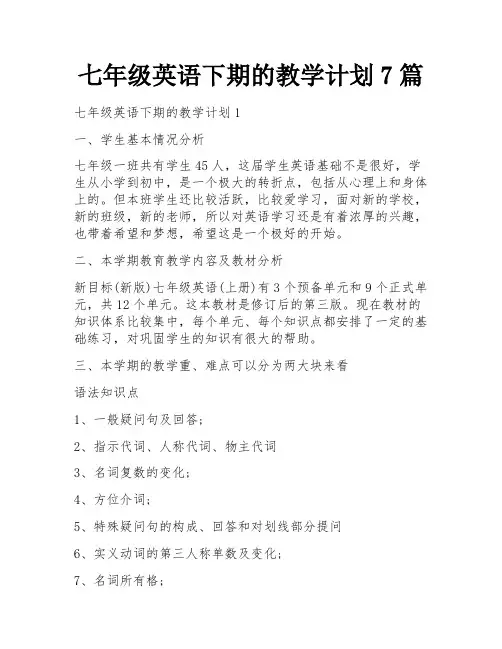
七年级英语下期的教学计划7篇七年级英语下期的教学计划1一、学生基本情况分析七年级一班共有学生45人,这届学生英语基础不是很好,学生从小学到初中,是一个极大的转折点,包括从心理上和身体上的。
但本班学生还比较活跃,比较爱学习,面对新的学校,新的班级,新的老师,所以对英语学习还是有着浓厚的兴趣,也带着希望和梦想,希望这是一个极好的开始。
二、本学期教育教学内容及教材分析新目标(新版)七年级英语(上册)有3个预备单元和9个正式单元,共12个单元。
这本教材是修订后的第三版。
现在教材的知识体系比较集中,每个单元、每个知识点都安排了一定的基础练习,对巩固学生的知识有很大的帮助。
三、本学期的教学重、难点可以分为两大块来看语法知识点1、一般疑问句及回答;2、指示代词、人称代词、物主代词3、名词复数的变化;4、方位介词;5、特殊疑问句的构成、回答和对划线部分提问6、实义动词的第三人称单数及变化;7、名词所有格;8、一般现在时。
9、时间表达法。
四、本学期将采用的教育教学方法英语教学法有很多种,各有利弊。
我们可以根据不同的情况采取不同的教学方法来弥补。
对于我教的班级,我打算在这学期用以下方式教育他们:1、用英语教英语(TeachEnglishinEnglish);英语毕竟是一门语言,训练的是学生的听、说、读、写、译的综合能力,在教学的过程中需要对学生的听、说、读、写、译的能力进行很多的训练,这就要求我们用英语来教英语,在课堂上对学生进行各种能力的训练。
2、用英语想英语(ThinkEnglishinEnglish);用英语想,也就是用英语思考。
学英语而不用英语思考,一定学不好。
用英语思考就是在用英语进行表达和理解时,没有本族语思考的介入,或者说本族语思考的介入被压缩到了极不明显的程度。
这是真正流利、熟练的境界和标志。
3、背诵和多种练习结合实事求是地说,背诵大量课文和大量练习相结合,是在各种不同条件下英语教学普遍有效的方法。

七年级英语下册教学计划七年级英语下册教学计划14篇时间的脚步是无声的,它在不经意间流逝,前方等待着我们的是新的机遇和挑战,来为今后的学习制定一份计划。
什么样的计划才是好的计划呢?下面是小编帮大家整理的七年级英语下册教学计划,欢迎阅读,希望大家能够喜欢。
七年级英语下册教学计划1一个寒假转眼间就过去了,新的学期又将开始,为了下学期更好地搞好七级英语教学工作,特做以下教学计划:一、指导思想依据学生上学期掌握知识情况和学生的生理和心理以及发展需求,本学期我们的英语课程的教学目的是如何培养学生的口语表达能力、听力水平和语言表达能力。
教师要激发学生学习英语的兴趣,培养他们学习英语的积极态度,使他们建立学习英语的自信心;培养学生的语感和良好的语音、语调基础,使他们形成初步运用英语进行日常交流的能力,为进一步学习打下基础。
同时用新课标理念,结合新课标精神,进行课堂改革,实行教与学的互动。
采用任务型语言教学模式,努力用一套行之有效的课堂教学模式,提高教学效率。
二、基本情况经过一学期的学习体会,我所教的两个班,大部分学生学习目的明确,学习态度端正,掌握了英语学习的一些基本方法,能够积极主动认真地学习,学习成绩较好。
但还有少部分学生没有明确的学习目的,缺少学习的热情和主动性,自觉性和自控力都较差,相应的学习习惯也差。
主要原因是没有激发学生学习英语的兴趣,学生觉得英语学习是一种负担,而不是一种乐趣。
一部分学生没有掌握记忆单词的方法,连基本的单词听写也不过关,导致看不懂,听不懂,学不懂。
学生的听力也还有待提高,在这方面失分也较多。
主要是听的时间太少,接触英语的时间不多。
针对种种问题,在本学期的英语教学中,教师一方面应加强基础知识的讲解和基本技能的训练,让学生掌握词汇、语法、句型等基础知识和听、说、读、写等基本技能,为进一步学习英语打下坚实的基础;另一方面,又要采取多种措施,注意培养学生对英语的兴趣;让学生掌握记忆单词、听力、写作等英语学习技艺,培养良好的学习习惯和自主探索,合作探究能力。
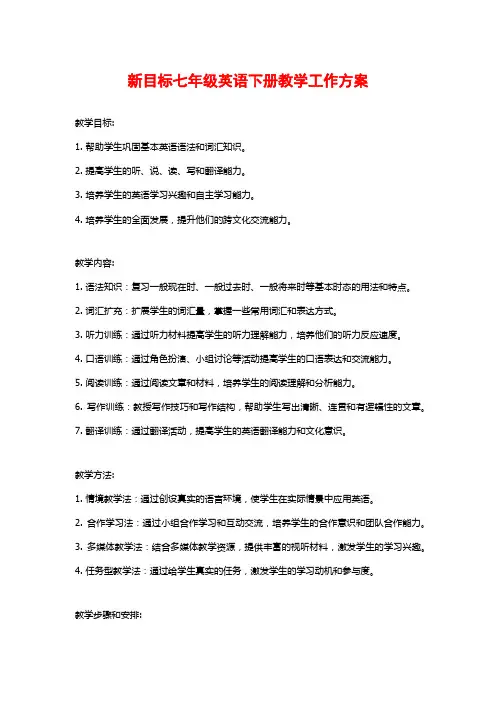
新目标七年级英语下册教学工作方案教学目标:1. 帮助学生巩固基本英语语法和词汇知识。
2. 提高学生的听、说、读、写和翻译能力。
3. 培养学生的英语学习兴趣和自主学习能力。
4. 培养学生的全面发展,提升他们的跨文化交流能力。
教学内容:1. 语法知识:复习一般现在时、一般过去时、一般将来时等基本时态的用法和特点。
2. 词汇扩充:扩展学生的词汇量,掌握一些常用词汇和表达方式。
3. 听力训练:通过听力材料提高学生的听力理解能力,培养他们的听力反应速度。
4. 口语训练:通过角色扮演、小组讨论等活动提高学生的口语表达和交流能力。
5. 阅读训练:通过阅读文章和材料,培养学生的阅读理解和分析能力。
6. 写作训练:教授写作技巧和写作结构,帮助学生写出清晰、连贯和有逻辑性的文章。
7. 翻译训练:通过翻译活动,提高学生的英语翻译能力和文化意识。
教学方法:1. 情境教学法:通过创设真实的语言环境,使学生在实际情景中应用英语。
2. 合作学习法:通过小组合作学习和互动交流,培养学生的合作意识和团队合作能力。
3. 多媒体教学法:结合多媒体教学资源,提供丰富的视听材料,激发学生的学习兴趣。
4. 任务型教学法:通过给学生真实的任务,激发学生的学习动机和参与度。
教学步骤和安排:1. 每节课开始前进行课前预热,可以通过问候、复习前面几节课内容或进行一些小游戏来引起学生的注意力和积极参与。
2. 在讲解新课内容之前,复习前面几节课的知识点,巩固学生的基础知识。
3. 讲解新课内容并做示范,引导学生理解和掌握新知识。
4. 练习和巩固:通过练习题、活动、小组讨论等方式进行练习和巩固。
5. 听力训练:听力材料可以选择与课文相关的对话、短文、新闻等,要求学生听懂并回答问题。
6. 口语训练:进行角色扮演、情景对话、小组讨论等活动,让学生能够自由表达思想和观点。
7. 阅读训练:选择有趣的短文和文章,让学生在阅读中提高理解能力和应用能力。
8. 写作训练:教授写作技巧和结构,让学生写作短文、日记、信件等,提高写作能力。
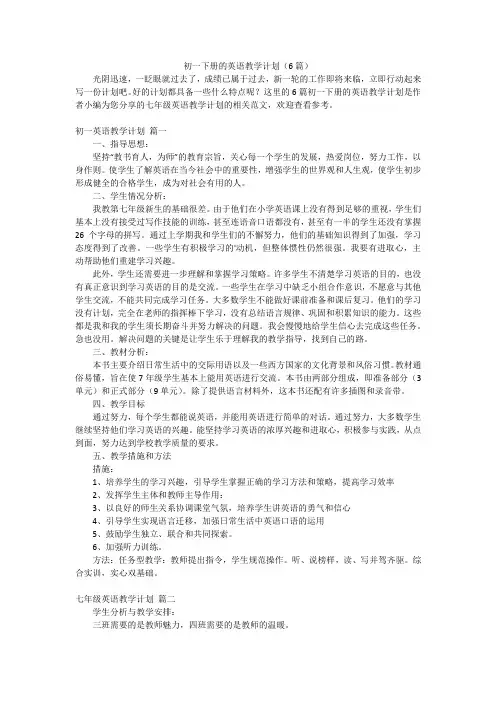
初一下册的英语教学计划(6篇)光阴迅速,一眨眼就过去了,成绩已属于过去,新一轮的工作即将来临,立即行动起来写一份计划吧。
好的计划都具备一些什么特点呢?这里的6篇初一下册的英语教学计划是作者小编为您分享的七年级英语教学计划的相关范文,欢迎查看参考。
初一英语教学计划篇一一、指导思想:坚持“教书育人,为师”的教育宗旨,关心每一个学生的发展,热爱岗位,努力工作,以身作则。
使学生了解英语在当今社会中的重要性,增强学生的世界观和人生观,使学生初步形成健全的合格学生,成为对社会有用的人。
二、学生情况分析:我教第七年级新生的基础很差。
由于他们在小学英语课上没有得到足够的重视,学生们基本上没有接受过写作技能的训练,甚至连语音口语都没有,甚至有一半的学生还没有掌握26个字母的拼写。
通过上学期我和学生们的不懈努力,他们的基础知识得到了加强,学习态度得到了改善。
一些学生有积极学习的'动机,但整体惯性仍然很强。
我要有进取心,主动帮助他们重建学习兴趣。
此外,学生还需要进一步理解和掌握学习策略。
许多学生不清楚学习英语的目的,也没有真正意识到学习英语的目的是交流。
一些学生在学习中缺乏小组合作意识,不愿意与其他学生交流,不能共同完成学习任务。
大多数学生不能做好课前准备和课后复习。
他们的学习没有计划,完全在老师的指挥棒下学习,没有总结语言规律、巩固和积累知识的能力。
这些都是我和我的学生须长期奋斗并努力解决的问题。
我会慢慢地给学生信心去完成这些任务。
急也没用。
解决问题的关键是让学生乐于理解我的教学指导,找到自己的路。
三、教材分析:本书主要介绍日常生活中的交际用语以及一些西方国家的文化背景和风俗习惯。
教材通俗易懂,旨在使7年级学生基本上能用英语进行交流。
本书由两部分组成,即准备部分(3单元)和正式部分(9单元)。
除了提供语言材料外,这本书还配有许多插图和录音带。
四、教学目标通过努力,每个学生都能说英语,并能用英语进行简单的对话。
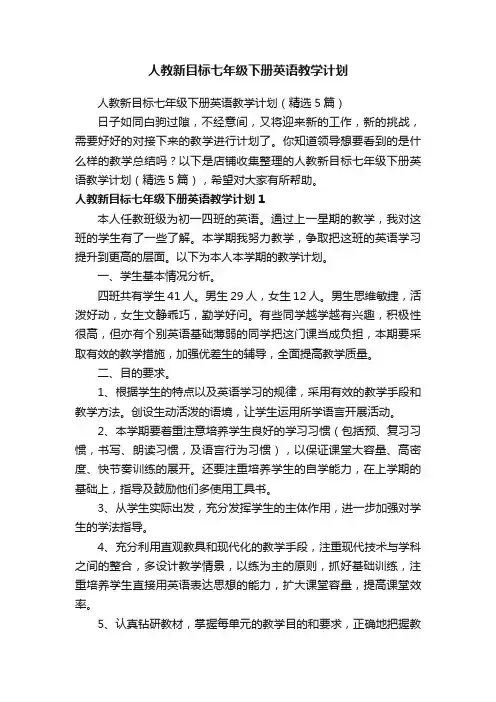
人教新目标七年级下册英语教学计划人教新目标七年级下册英语教学计划(精选5篇)日子如同白驹过隙,不经意间,又将迎来新的工作,新的挑战,需要好好的对接下来的教学进行计划了。
你知道领导想要看到的是什么样的教学总结吗?以下是店铺收集整理的人教新目标七年级下册英语教学计划(精选5篇),希望对大家有所帮助。
人教新目标七年级下册英语教学计划1本人任教班级为初一四班的英语。
通过上一星期的教学,我对这班的学生有了一些了解。
本学期我努力教学,争取把这班的英语学习提升到更高的层面。
以下为本人本学期的教学计划。
一、学生基本情况分析。
四班共有学生41人。
男生29人,女生12人。
男生思维敏捷,活泼好动,女生文静乖巧,勤学好问。
有些同学越学越有兴趣,积极性很高,但亦有个别英语基础薄弱的同学把这门课当成负担,本期要采取有效的教学措施,加强优差生的辅导,全面提高教学质量。
二、目的要求。
1、根据学生的特点以及英语学习的规律,采用有效的教学手段和教学方法。
创设生动活泼的语境,让学生运用所学语言开展活动。
2、本学期要着重注意培养学生良好的学习习惯(包括预、复习习惯,书写、朗读习惯,及语言行为习惯),以保证课堂大容量、高密度、快节奏训练的展开。
还要注重培养学生的自学能力,在上学期的基础上,指导及鼓励他们多使用工具书。
3、从学生实际出发,充分发挥学生的主体作用,进一步加强对学生的学法指导。
4、充分利用直观教具和现代化的教学手段,注重现代技术与学科之间的整合,多设计教学情景,以练为主的原则,抓好基础训练,注重培养学生直接用英语表达思想的能力,扩大课堂容量,提高课堂效率。
5、认真钻研教材,掌握每单元的教学目的和要求,正确地把握教材的重点和难点,根据的学生年龄特点及班级的实际情况,精心设计教学程序,选择适当的教学方法,写出各单元中的每课教案。
三、具体措施总原则:提高课堂利用率,有效利用课堂时间。
尽可能地挖掘优等生的潜力,促使其提高。
对于成绩较弱者,针对性地进行帮补,并通过优等生的帮助促其进步。
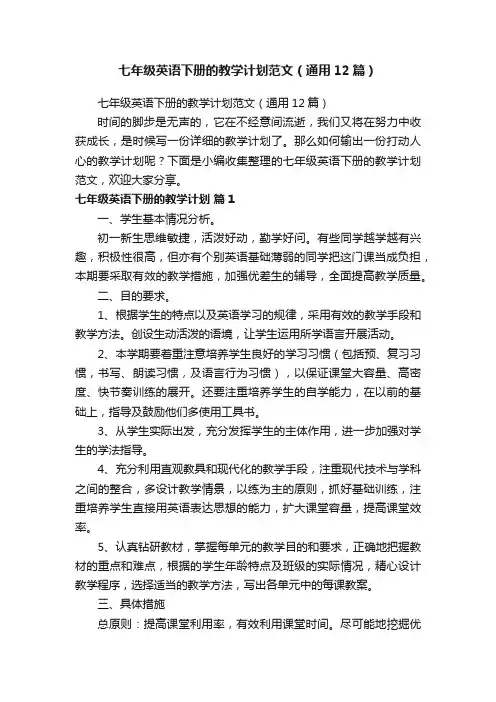
七年级英语下册的教学计划范文(通用12篇)七年级英语下册的教学计划范文(通用12篇)时间的脚步是无声的,它在不经意间流逝,我们又将在努力中收获成长,是时候写一份详细的教学计划了。
那么如何输出一份打动人心的教学计划呢?下面是小编收集整理的七年级英语下册的教学计划范文,欢迎大家分享。
七年级英语下册的教学计划篇1一、学生基本情况分析。
初一新生思维敏捷,活泼好动,勤学好问。
有些同学越学越有兴趣,积极性很高,但亦有个别英语基础薄弱的同学把这门课当成负担,本期要采取有效的教学措施,加强优差生的辅导,全面提高教学质量。
二、目的要求。
1、根据学生的特点以及英语学习的规律,采用有效的教学手段和教学方法。
创设生动活泼的语境,让学生运用所学语言开展活动。
2、本学期要着重注意培养学生良好的学习习惯(包括预、复习习惯,书写、朗读习惯,及语言行为习惯),以保证课堂大容量、高密度、快节奏训练的展开。
还要注重培养学生的自学能力,在以前的基础上,指导及鼓励他们多使用工具书。
3、从学生实际出发,充分发挥学生的主体作用,进一步加强对学生的学法指导。
4、充分利用直观教具和现代化的教学手段,注重现代技术与学科之间的整合,多设计教学情景,以练为主的原则,抓好基础训练,注重培养学生直接用英语表达思想的能力,扩大课堂容量,提高课堂效率。
5、认真钻研教材,掌握每单元的教学目的和要求,正确地把握教材的重点和难点,根据的学生年龄特点及班级的实际情况,精心设计教学程序,选择适当的教学方法,写出各单元中的每课教案。
三、具体措施总原则:提高课堂利用率,有效利用课堂时间。
尽可能地挖掘优等生的潜力,促使其提高。
对于成绩较弱者,针对性地进行帮补,并通过优等生的帮助促其进步。
1、在课堂上体现知识的梯度,扩大照顾面。
2、引导学生找出适合自己的学习方法,把握好学习的各个环节,让他们能养成自觉学习英语的习惯。
3、实施“一帮一”活动,让成绩好的同学带动差生,同时亦监督差生每天的作业完成情况和背诵情况。
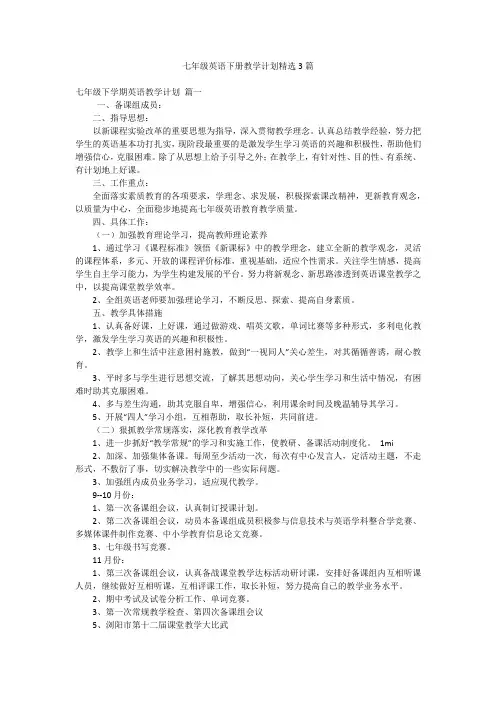
七年级英语下册教学计划精选3篇七年级下学期英语教学计划篇一一、备课组成员:二、指导思想:以新课程实验改革的重要思想为指导,深入贯彻教学理念。
认真总结教学经验,努力把学生的英语基本功打扎实,现阶段最重要的是激发学生学习英语的兴趣和积极性,帮助他们增强信心,克服困难。
除了从思想上给予引导之外;在教学上,有针对性、目的性、有系统、有计划地上好课。
三、工作重点:全面落实素质教育的各项要求,学理念、求发展,积极探索课改精神,更新教育观念,以质量为中心,全面稳步地提高七年级英语教育教学质量。
四、具体工作:(一)加强教育理论学习,提高教师理论素养1、通过学习《课程标准》领悟《新课标》中的教学理念,建立全新的教学观念,灵活的课程体系,多元、开放的课程评价标准,重视基础,适应个性需求。
关注学生情感,提高学生自主学习能力,为学生构建发展的平台。
努力将新观念、新思路渗透到英语课堂教学之中,以提高课堂教学效率。
2、全组英语老师要加强理论学习,不断反思、探索、提高自身素质。
五、教学具体措施1、认真备好课,上好课,通过做游戏、唱英文歌,单词比赛等多种形式,多利电化教学,激发学生学习英语的兴趣和积极性。
2、教学上和生活中注意困村施教,做到“一视同人”关心差生,对其循循善诱,耐心教育。
3、平时多与学生进行思想交流,了解其思想动向,关心学生学习和生活中情况,有困难时助其克服困难。
4、多与差生沟通,助其克服自卑,增强信心,利用课余时间及晚温辅导其学习。
5、开展“四人”学习小组,互相帮助,取长补短,共同前进。
(二)狠抓教学常规落实,深化教育教学改革1、进一步抓好“教学常规”的学习和实施工作,使教研、备课活动制度化。
1mi2、加深、加强集体备课。
每周至少活动一次,每次有中心发言人,定活动主题,不走形式,不敷衍了事,切实解决教学中的一些实际问题。
3、加强组内成员业务学习,适应现代教学。
9--10月份:1、第一次备课组会议,认真制订授课计划。

新目标英语七年级下册的教学计划(精选21篇)新目标英语七年级下册的教学计划新目标英语七年级下册的教学计划(精选21篇)日子在弹指一挥间就毫无声息的流逝,为了以后教学质量不断提高,不如为接下来的教学做个教学计划吧。
那么教学计划要怎么写才能突出呢?下面是小编为大家收集的新目标英语七年级下册的教学计划(精选21篇),仅供参考,希望能够帮助到大家。
新目标英语七年级下册的教学计划1本学期总共有4个月,中间有二测考试,而后又将面临升学考试,所以教学上需注意很多问题。
另外,由于种种原因,上学期一测本人教的两班成绩比较糟糕,虽然各种方法都尝试过,以为会有突破,但结果让人失望。
本学期我打算进行如下教学工作:一、继续加大教学的投入上学期在这方面的确做了大量的工作,一测前有一半的学生已开始勤奋学习。
但这两个班还是有相当一部分学生不知道学习,或者缺少勤奋的品质,或是没有独立思考的习惯。
另外,还有不少学生不能虚心接受老师的批评,一直骄傲、浮躁。
还有的明显很散漫,但还说自己已经比较努力了,不知道其他班的同学正在进步,所以整日贪玩,而一旦自己成绩退步时又。
这些也是让老师都感棘手的问题。
在本学期刚开学时就要再想一些办法让学生真正懂得学习,思想上不端正态度,老师付出再多也没有多大用处。
可以通过在讲题的过程中抽查学生的掌握情况,结合出现的问题加大对学生的教育。
也可借其它随机出现的问题让学生转变态度。
本学期要继续做好培优补差工作,关键是要抓细、抓严。
而我还认为这也不是一个老师所能做到的,要联合起来共同抓好这方面的工作。
要努力培养班级浓厚的学习氛围,否则培优和补差都实现不了,这方面上学期已有了教训。
这学期主要是复习,在课堂内外要多练习,多让学生识记考点知识,多读课文。
在听力和阅读理解方面多做练习,每星期还要进行至少一次的作文练习。
我将从各个方面把工作做得再细一些,并且务必再专注一些,争取在个人的教学上有切实的进步。
二、继续做好德育工作在这一方面我认为还是做得比较好的。
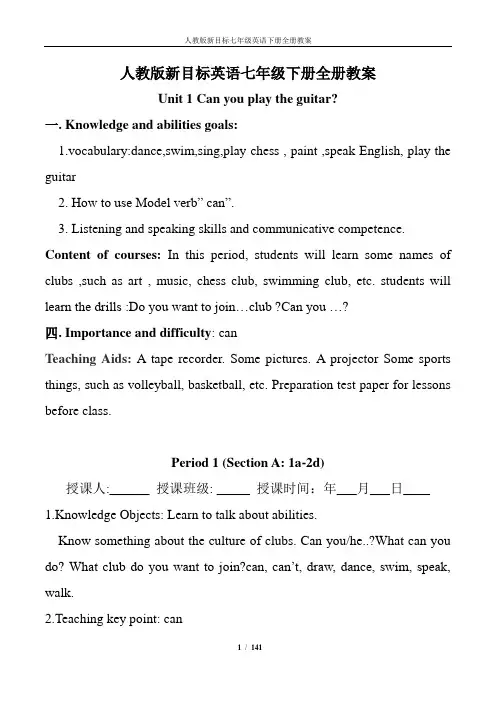
人教版新目标英语七年级下册全册教案Unit 1 Can you play the guitar?一. Knowledge and abilities goals:1.vocabulary:dance,swim,sing,play chess , paint ,speak English, play the guitar2. How to use Model verb” can”.3. Listening and speaking skills and communicative competence. Content of courses:In this period, students will learn some names of clubs ,such as art , music, chess club, swimming club, etc. students will learn the drills :Do you want to join…club ?Can you …?四. Importance and difficulty: canTeaching Aids: A tape recorder. Some pictures. A projector Some sports things, such as volleyball, basketball, etc. Preparation test paper for lessons before class.Period 1 (Section A: 1a-2d)授课人:______ 授课班级: _____ 授课时间:年___月___日____ 1.Knowledge Objects: Learn to talk about abilities.Know something about the culture of clubs. Can you/he..?What can you do? What club do you want to join?can, can’t, draw, dance, swim, speak, walk.2.Teaching key point: can3. Teaching Difficult point: can4.Teaching Procedures:Step 1. Lead-inEnjoy a song I’m a musicianT: Do you want to be a musician? S:T: Can you play the piano? S…T: What can you do? S: I can…T: What about you? S:T: OK, now please show your talent and tell us what you can do.Ask one of the students come to the front and do the action. Ask other students to guess what he or she can do.Step 2. PresentationT: Look at the pictures. What are they doing? S:Step 3 Pair workLook at the pictures. Ask and answer like this:A: Can you play basketball?B: Yes, I can. / No, I can’t.Can you…?Step 4 PresentationShow some pictures of famous stars. Practice the third person “he, she, they”T: Where can you play chess? S:T: Yes, in a chess club. This term, we have a lot of clubs. What club do youwant to join? S…T: Sounds great. Can you…?S: Yes, I can/ No, I can’tIf the answer is negative, guide students to say:S: No, I can’t. But I can learn it from others.Step5 Pair workA: What club do you want to join?B: I want to join the…A: Can you …?B: Yes, I can . No, I can’t. But I can learn it from others.Step 6 ListeningListen to 1bListen to 2a and 2b. Tell them to give special attention to listening activity (names of the clubs). Finish the tasks.Step 7 Pair workLook at 2b and talk about what the people can do the clubs they want to join.Step 7 Role-play the conversation 2dT: If you like telling stories. What club can you join?S: Story telling club.T: Right. Please read the conversation following the recording. Who wants to join the story telling club? Then role-play the conversation.Step 8 Explain some language points.Step 9 HomeworkPeriod 2 (Section A: 3a-3c)授课人:______ 授课班级: _____ 授课时间:——年___月___日____1. Knowledge Objects: go on learning to talk about abilities.—Can you play the guitar? —Yes, I can./ No, I can't.—What can you do? —I can dance.—What club do you want to join? —I want to join the chess club.2. Teaching key points: Conclude the usage of ‘can’; put all new language into practice through different activities.3. Teaching Difficult points: Distinguish “say, speak, tell, talk”4.Teaching Procedures:Step1:Greeting, Warming up and duty report.Watch a flash about the content of the Just for fun.Talk something about the flash: Why is the other boy unhappy?Introduce because of the difference of time zones, the time in different places are different.Revision: show the time in six places: Beijing, Tokyo, Paris, Los Angeles, New York, and London. Elicit the sentence pattern: What time is it?It’s……Draw attention to the “am” and “pm”. For instance, Beijing is seven o’clock in the morning. We can say Beijing is seven am. Los Angeles is three in the afternoon. So we can say Los Angeles is three pm. (teacher helps students answer).Step2:Review the words learnt in the last period and add more.(1)T:Here are some Chinese, let us see what time do they usually get up/ take a shower…get up take a shower eat breakfast go to school eat lunch run go homedo homework eat dinner go to bed(2)ask students to make a surveyAsk your friend 5 questions about his /her day. Then make a report. A: What time do you usually…?B: I usually…at…Step3:presentation.(1)Ben’s day. Introduce something about Ben.Using the sentence pattern: What time does he usually get up/go to school/…Pay attention to the verb form of the third person.Discuss Do you like ben’;s routines.(2)Show the picture of Scott. He usually gets up at 5 pm.Ask students to predict what his job is?(3)listen to the tape,and try to answer this question. then read through the passage,and match the pictures with the times.(4)read it again and fill in the chart.(5)answer the following questions1.Where does he work?2.How does he go to work?Step4:Work on 3a.(1)Read through the passage and tell me what his job is.(2)Read it again and match the pictures.(3)Answer questions:What does he do after he get up?Does he go to work after breakfast? What does he do?How does he go to work? By bus or on foot?What does he do before he goes to bed?What does“What a funny time to eat breakfast!”mean?Step5:Follow up.T:My friend Da Bao likes Scott's work, so he gets to Sai Te Hotel . But he doesn't find him.T: There are many children in the hotel. Look, they are coming. Please ask them questions to find the real Scott.Step6:Work on part4.T:Now six people make a group, and ask the other students when theyusually go to bed . The leader lines up from the earliest to the latest bedtime.T: Let's listen Group1…Group2…Step7:Work on part 3 of self –check.T: Now I want to know something about what you do on weekends. You can go, ask your classmates and fill in the forms. Then you have a report. T: You may begin it like this "Ma Li gets up at …"Step8:Homework.Oral work:(1)Read 3a and recite it.(2)Go on making a survey to find out what your classmates do on weekends.Period 3 (Section B: 1a-1f)授课人:______ 授课班级: _____ 授课时间:——年___月___日____1. Knowledge Objects: go on learning to talk about abilities. drum, play the drum, piano, play the piano, violin, play the violin2. Teaching key points: Improve listening and speaking3. Teaching Difficult points: Improve listening and speaking4. Teaching Procedures:Step 1 Warming- up and revisionDaily greeting.Check the homework. Let some Ss report what his/her family members can do.Step 2 PresentationPlay the sound of different kinds of instruments. Let Ss guess what it is.Act and show your classmates your talent.T: Please stand in front of your classmates. Act and say what you can.S1: (sing and dance) I can sing and dance.S2: (play the drum) I can play the drum..Step 3 ListeningTell the Ss that they will listen to some sounds of the instruments. Listen and number the words [1-4] in the order of the sounds you hear in 1a. Play the recording again and check the answers.T: Now let's work on 1c. First, let one student read the words and phrases aloud.Then listen to the 1d and circle the words and phrase you hear.Check the answers:T: Now please look at the chart in 1e. What can Bill, Cindy and Frank do? What can't they do? You'll listen to the recording again. Then try to fill in the blanks.Step 4 Group workWork in groups. Take turn to talk about what Bill, Cindy and Frank can and can't do.S1: Bill can play the guitar, but he can't sing.S2: Cindy can sing and play the drum, but he can't play the piano. Teacher can walk around the classroom, and give some help to the Ss. Step 5 HomeworkMake up a conversation between a volunteer and a person who is in charge of a sports club/old people’s home/music club.Period 4 (Section B: 2a-self check)授课人:______ 授课班级: _____ 授课时间:——年___月___日____ 1. Knowledge Objects: go on learning to talk about abilities. also, people, help (sb) with sth, center, home, today, be good with, make, make friends, weekend, on weekends/on the weekend, teach, musician2. Teaching key points: Also, too; be good with, help with3. Teaching Difficult points: Describe one’s ability4. Teaching Procedures:Step 1 Warming-upCheck the homeworkAsk some pairs to show their conversationsStep 2 ReadingFirst, show some pictures of the boys and girls and some key words in 2a.T: Here are some pictures and information about Peter, Alan and Ma Huan. Can you describe them according to the pictures and key words?S1: Guide Ss to use “also, too”, and distinguish how to use these two words.Give comments on Ss’ descriptions.T: Now we’ll read three ads. What's the main idea of each ad? What's each ad's title? Now let's read the three ads and select a title for each ad. Ss read carefully and try to select a title for each ad. Check the answers with the class.Step 3 Review the usage of “tell”,Review and distinguish the usage and function of “help”T: Suppose Peter, Alan and Ma Huan want to help to do something after school. Which ad is right for him/her? Now read the descriptions in 2a and the ads in 2b again. Select a right ad for each person.Ss read the descriptions in 2a and the ads in 2b again. Try to select a right ad for each person. They can talk about the answers in their groups. Check the answers with the class.Step 4 Homework1. Recite 2a and 2b2. Finish the exercise on p6Unit 2 What time do you go to school?1. Teaching Aims:1) Aims of Basic Knowledge:①V ocabulary: time, shower, usually, O’clock, what time, go to school,take a shower.②Grammar: What time do you…? What time does he / she…?③ Function: Use the simple tense to talk about the daily life.2) Aims of Abilities: Listening skill. Speaking skill. Reading skill. Writing skill.3) Aims of Emotion: Love life.2. Analysis of the Material:1) Brief Introduction of the teaching material:What time / When do you…?” “ What time / When does he…?”2) Teaching Focus: What time do you…? What time does he/ she…?3) Teaching Difficulties: Present tense.3. Learning Methods: Make a plan. Culture.4. Teaching Methods: Student- centered. Task-based Teaching.5. Teaching Time: 4 periodsPeriod 1(Section A: 1a-2a)授课人:______ 授课班级: _____ 授课时间:——年___月___日____Step One: Warming-upGreetingT: Good afternoon, everyone.Ss: Good afternoon, Miss Yang.Step Two: Presentation1.Adjust the time, and ask students questions.T: What time is it? Ss: It’s 12 o’clock. ( Write on Bb )( Help Ss to say )T: What time is it? Ss: It’s 10:15.( Help Ss to say )2.Ask one student to come to the front, adjust the time and ask theother students.S1: What time is it? Ss: It’s 9 o’clock.3.Teach the new words & phrases.Show some pictures of different clocks and the activities.T: I’m very busy these days. Can you guess what time I get up / eat breakfast / go to school / run / take a shower? ( Write on Bb)T: I usually get up at 6:35. ( Teach Ss the new word “ usually” )S1: Yo u usually eat breakfast at …S2: You usually run at…S3: You usually take a shower at …4.Ask Ss to do the exercise of 1a, and then check the answers.Step Three: Listening1.Show Ss the timetable of Rick’s ( write on small Bb )Rick’s timetableAsk Ss listen to the recorder and fill in the chart.Then check the answers.2.Ask and answer.T: What time does Rick get up / eat breakfast / run / go to school / take a shower ?Ss: He gets up / eats breakfast / runs / goes to school / takes a shower at…( Ask Ss pay attention to the underlined phrases.)Step Four: Consolidation1.Ask Ss to look at the pictures and tell their days.Example: I usually get up at …. I eat breakfast at …. I go to school at ….At …, I take a shower.Step Six: Homework1.Try to remember all the words & phrases.2.Survey: Ask your classmates their routines, and give your report.3.Plan: January 1st is coming. Please plan it, and make your daywonderful.Step Seven Blackboard DesignPeriod 2 (Section A: 2b-Grammar Focus)授课人:______ 授课班级: _____ 授课时间:——年___月___日____1. Aims and demands :1) Language skills :Ss learn to talk about kinds of transportation, and how long it takes to go places, and how far apart places are.2) Target Language : Words : how far , get to , bicycle , subway , bus stop, train station , minute, kilometer, mile , transportation , calendar Sentences: How do you get to school ? / How long does it take ? / How far is it ?3) Moral object : Through learning this unit , Ss can enable them to care for each other whenever crossing the roads and pay attention to the sign of traffic.2. Analysis of the material:Students have learned the transportation before.. In this unit ,they need to learn more details about the transportation. At the same time ,they need tolearn “How long and How far” and they can use them freely.3. Teaching methods:pairwork , groupwork ,listening and speaking, practicing4, learning strategies:Personalizing Inferring vocabulary5.Teaching aids:Tape recorder, a projector or a computer6.Teaching period:Four periods.Period 3 (Section B: 3a-3c)授课人:______ 授课班级: _____ 授课时间:——年___月___日____1. Aims and Demands: Key vocabulary, How do you get to school ? Howdoes he get to school ?2. Teaching methods : Listening Writing Pairwork3. Teaching Aids : A tape recorder.Step I Leading inT: Good morning, everyone! You know I live far away ,so I go to school by bus every day. What about you? David, “How often do you go to school?”S:--------T: So we will talk about how to get to places in this unit.Step IINow I will show you pictures and let’s review the transportations we know. Then we will learn more about it .(take the subway) Please open your books and finish 1a.Step III1. There are five names in 1b.Now they are in the picture. We should find them.2. Play the tape .They should listen carefully and find the persons .Write the numbers next to the correct students in the picture above. After listening , check the answers together .Step IVPoint to the example in the box , ask two students to read it .then ask them to make up their conversations about how the people in the picture get to school .Teacher choose some pairs to act their conversations.Step VPracticing the listening :T: I will play two conversations The people are talking about how students get to school and how long it takes .The first time check the kinds of transportation that you hear. The second time match the time with the kinds of transportation activity 2a.Step VI1. Pay attention to the picture and dialogue.2. Make your own dialogue into pairs.3. Act it in front of the students.Step VIISummary and homework: This class we have learnt some key vocabulary and the target language .I hope after class you can survey how does your friends get to school .and pre-revise the 3a,3b.Step VIII Blackboard DesignPeriod 4授课人:______ 授课班级: _____ 授课时间:——年___月___日____3. Ask some students to do it orally.Unit 3 How do you get to school ?Period 1 (Section A: 1a-1C)授课人:______ 授课班级: _____ 授课时间:——年___月___日____ 【学习目标】1.掌握本节课的5个单词:train bus subway ride bike 和5个短语: take the train take the bus take the subway ;ride the bike walk to2.熟练运用问方式的句型。
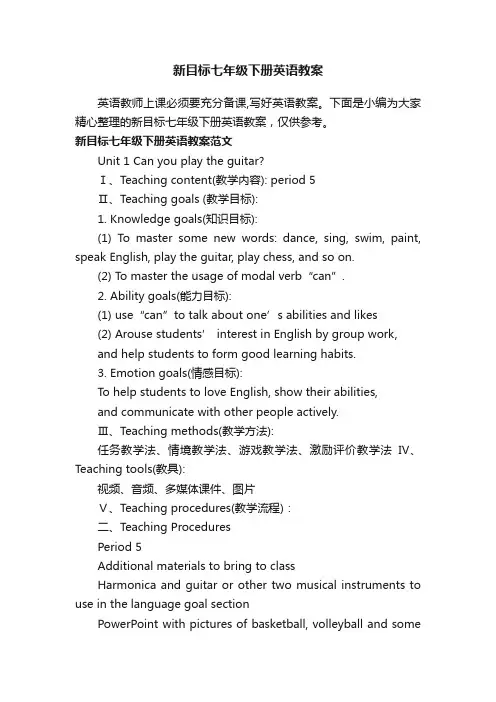
新目标七年级下册英语教案英语教师上课必须要充分备课,写好英语教案。
下面是小编为大家精心整理的新目标七年级下册英语教案,仅供参考。
新目标七年级下册英语教案范文Unit 1 Can you play the guitar?Ⅰ、Teaching content(教学内容): period 5Ⅱ、Teaching goals (教学目标):1. Knowledge goals(知识目标):(1) To master some new words: dance, sing, swim, paint, speak English, play the guitar, play chess, and so on.(2) To master the usage of modal verb“can”.2. Ability goals(能力目标):(1) use“can”to talk about one’s abilities and likes(2) Arouse students’ interest in English by group work,and help students to form good learning habits.3. Emotion goals(情感目标):To help students to love English, show their abilities,and communicate with other people actively.Ⅲ、Teaching methods(教学方法):任务教学法、情境教学法、游戏教学法、激励评价教学法Ⅳ、Teaching tools(教具):视频、音频、多媒体课件、图片Ⅴ、Teaching procedures(教学流程):二、Teaching ProceduresPeriod 5Additional materials to bring to classHarmonica and guitar or other two musical instruments to use in the language goal sectionPowerPoint with pictures of basketball, volleyball and somemusic instruments.Step 1 Revision and lead inThe teacher says I like basketball. Then asks: Do you like basketball/ volleyball? Do you want to join a basketball club? Step 2 PresentationAsk the students to look at the pictures of Page 5 , there are some clubs in it. Let’s look at the clubs. What are they? They are art club, English club, chess club, swimming club and music club. What club do you want to join? Help the students to answer I want to join the art club and so on.If the school has clubs, the teacher can ask the students: What clubs do we have in our school?The teacher writes What club do you want to join? I want to join… on the blackboard. Ask the students to practice it. Then introduces the key vocabularies and the words can and can’t.The teacher says to the students who say he/she wants to join the basketball club: Can you play basketball? Help the students say Yes, I can. No, I can’t. Then repeat with other actions or pictures, such as play volleyball.Show the students the activities the people in each club can do with the same step.Then repeat with dance, swim, play chess, paint, speak English and play the guitar with the help of doing the action. Or we can use the PowerPoint to help us to show the students what we can do. The teacher can ask the students to practice the following dialogues with can.Can you dance? Yes, I can. / No, I can’t.Can he paint? Yes, he can. /No, he can’t. Can she speak English? Yes, she can. / No, she can’t.Can you speak English? Yes, we can. / No, we can’t.Can you play it well? Yes, I can. / No, I can’t.Do the action and read the new words and phrases.Ask the students to practice can and can’t. Ask the students to practice can you play it well?At the same time, the teacher write down sing, dance, swim, play chess, paint, speak English, and play the guitar on the blackboard. Ask the students to read after the teacher. Step 3 A gameTo be more familiar with the words and phrases, the teacher can organize a game like this:Write the words and phrases on pieces of paper. Ask one of the students come to the front and choose one of the paper, then do the action. Ask other students to guess what he or she can do. Then exchange.Step 4 ExerciseTask 1:Look at the pictures on Page 5. Points to the activities the people in each club are doing. Say something about each club’s activity clearly. For example, This is a chess club. See the chess? They are playing chess.Task 2.Say each conversation with a student in Part 2. After doing this, play the recording the first time. Students only listen. Play the recording a second time. This time ask the students to listen to the conversations and write a number 1 next to the first conversation they hear, a number 2 next to the second one they hear, and a number 3 next to the third one they hear. Point out the sample answer. The answers are c b aTask 31c.Say the sample conversations. Have students repeat. Thenask students to practice the conversations in pairs. Ask them to use the vocabulary from 2a. As students work, listen in on various pairs so that you can check progress and help with pronunciation as needed.After students have had a chance to practice the conversations, ask pairs to come to the front of the room and act out one of their conversations.Step 5 HomeworkTask : fill in the form. Write down three things you can do and three things you can not do.七年级英语作文篇The secretary told me that Mr. Harmsworth would see me. I felt very nervous when I went into his office. He did not look up from his desk when I entered. After I had sat down, he said that business was very bad. He told me that the firm could not afford to pay such large salaries. Twenty people had already left. I knew that my turn had come.'Mr.Harmsworth,' I said in a weak voice.'Don't interrupt,' he said.Then he smiled and told me I would receive an extra thousand pounds a year!秘书告诉我说哈姆斯沃斯先生要见我。

七年级下学期英语教学计划优秀5篇七年级英语下册教学计划篇一一、现状分析通过与初一学生一个学期的交往与了解,由于学生的个体差异,发现他们英语口语水平参差不齐。
大多数学生都只会几句日常交际用语,碰到较复杂的问题,学生就无所适从,灵活性较弱,语音语调不够自然流畅。
考试成绩出现“两极分化”现象,部分学生有厌学情绪。
二、工作目标1、加强教师间的教学交流,缩小班与班的成绩差距。
2、在日常教学中打好语法基础,强化听说训练。
3、加强学生自学方法习惯的形成于培养。
三、工作重点1、重视学生语言知识运用能力的培养,重视学生良好的学习习惯的养成。
1)培养查字典,使用工具书的习惯;2) 培养科学记忆单词的习惯;3) 留意课堂和课下衔接,培养书写规范化习惯;4) 培养用心听讲,积极思索,大胆参与的习惯;5) 提出要求,注重检查落实,培养学生课前预习,课堂做笔记的好习惯;2 。
在积极探索课堂教学改革的同时,坚持每周集体备课,发挥集体聪明,认真钻研教材,改进学案,创高效课堂。
有交流才有进步和提高。
初一英语组教师将针对新教材的特点,备课组全体成员要做到精心备课,吃透教材,根据每个单元各自特征和学生的实际能力,制定出不同教学设计方案,以此促进学生的积极性,根据教学内容设置的不同,结合我校的教学模式进行教学,力求教学明确目标,突出重点,抓住要害点和难点,充分调动学生的积极性,发挥学习主动性。
3、加强对学案导学的利用,注意传授知识与及时评价相结合,强化反馈,强化落实。
在课堂上力求把每节课的每个知识点,如语音、词汇、语法讲清晰、讲透彻。
针对有的教师在课堂上讲练多次,但学生仍未把握的情况,要注意及时把知识传授和评价结合起来,充分利用好课前2分钟,进行教师检测与自检,并及时讲评。
4、注意课内操练和课外积累相结合。
继承抓好课间口语操练,分班分层分组进行辅导及练习,制定专项训练:朗读、问答、口头作文;将本年级的英语角活动继续开展下去。
5、针对初一学生英语学习“两极分化”现象,我们将采取如下措施:1)准确领会《英语课程标准》教学内容、要求、原则,严格遵守英语教学规律。
七年级英语下册教学计划(优秀4篇)(经典版)编制人:__________________审核人:__________________审批人:__________________编制单位:__________________编制时间:____年____月____日序言下载提示:该文档是本店铺精心编制而成的,希望大家下载后,能够帮助大家解决实际问题。
文档下载后可定制修改,请根据实际需要进行调整和使用,谢谢!并且,本店铺为大家提供各种类型的经典范文,如总结报告、合同协议、规章制度、条据文书、策划方案、心得体会、演讲致辞、教学资料、作文大全、其他范文等等,想了解不同范文格式和写法,敬请关注!Download tips: This document is carefully compiled by this editor. I hope that after you download it, it can help you solve practical problems. The document can be customized and modified after downloading, please adjust and use it according to actual needs, thank you!Moreover, our store provides various types of classic sample essays, such as summary reports, contract agreements, rules and regulations, doctrinal documents, planning plans, insights, speeches, teaching materials, complete essays, and other sample essays. If you want to learn about different sample formats and writing methods, please pay attention!七年级英语下册教学计划(优秀4篇)时间的脚步是无声的,它在不经意间流逝,我们的教学工作又将翻开新的一页,不如为接下来的教学做个教学计划吧。
人教版(新目标)英语七年级下册教学计划-七年级下册教学计划以下是一个简单的人教版(新目标)英语七年级下册教学计划。
这个计划是根据教材内容和常规教学安排设计的,你可以根据具体情况进行调整和修改。
教学目标:1. 学会基本的英语单词和句型。
2. 培养学生的听、说、读、写能力。
3. 培养学生的合作学习和自主学习能力。
教学内容:Unit 1: I'm looking forward to the summer vacation.Unit 2: What's the matter?Unit 3: Can I help you?Unit 4: What are you doing?Unit 5: Can you come to my party?Unit 6: I'm watching TV.Unit 7: What does he look like?教学计划:第一周:- 教学目标:介绍课程和教材,学生互相认识。
- 活动:介绍自己和其他同学,学生互相交流并练习简单的问候语。
- 作业:背诵并准备介绍自己的短文。
第二周:- 教学目标:学习Unit 1的单词和短语。
- 活动:教学观看视频,学生练习单词和短语的发音,并分组进行朗读练习。
- 作业:练习单词和短语的拼写和应用。
第三周:- 教学目标:学习Unit 1的语法和句型。
- 活动:教学观看视频,学生跟读和模仿语音语调,然后进行角色扮演练习。
- 作业:完成Unit 1的课后练习和习题。
第四周:- 教学目标:学习Unit 2的单词和短语。
- 活动:教学观看视频,学生练习单词和短语的发音,并分组进行朗读练习。
- 作业:练习单词和短语的拼写和应用。
第五周:- 教学目标:学习Unit 2的语法和句型。
- 活动:教学观看视频,学生跟读和模仿语音语调,然后进行角色扮演练习。
- 作业:完成Unit 2的课后练习和习题。
以此类推,根据每个单元的内容和目标,进行相应的教学活动和作业安排,同时也可以根据学生的学习进度和能力进行适当的调整和修改。
七年级英语下工作教学计划5篇(经典版)编制人:__________________审核人:__________________审批人:__________________编制单位:__________________编制时间:____年____月____日序言下载提示:该文档是本店铺精心编制而成的,希望大家下载后,能够帮助大家解决实际问题。
文档下载后可定制修改,请根据实际需要进行调整和使用,谢谢!并且,本店铺为大家提供各种类型的经典范文,如工作计划、工作报告、演讲致辞、规章制度、心得体会、活动方案、应急预案、教学资料、作文大全、其他范文等等,想了解不同范文格式和写法,敬请关注!Download tips: This document is carefully compiled by this editor. I hope that after you download it, it can help you solve practical problems. The document can be customized and modified after downloading, please adjust and use it according to actual needs, thank you!Moreover, our store provides various types of classic sample essays, such as work plans, work reports, speeches, rules and regulations, personal experiences, activity plans, emergency plans, teaching materials, complete essays, and other sample essays. If you want to learn about different sample formats and writing methods, please pay attention!七年级英语下工作教学计划5篇只有将教学计划写得足够具体,这样才能便于今后教学的开展,大家写教学计划的目的就是帮助自己找到更合适自己的教学方式,本店铺今天就为您带来了七年级英语下工作教学计划5篇,相信一定会对你有所帮助。
人教版新目标七年级英语下册 Unit 9教学设计一. 教材分析人教版新目标七年级英语下册Unit 9主要围绕日常生活和一般现在时进行教学。
本单元主题明显,贴近学生生活,有利于激发学生的学习兴趣。
教材内容丰富,包括听力、口语、阅读和写作等方面,有助于学生全面提高英语水平。
此外,教材还设计了多样化的练习和活动,便于教师进行课堂教学和学生自主学习。
二. 学情分析七年级的学生已具备一定的英语基础,对日常生活话题有一定的了解。
但部分学生在语言表达和听力方面仍存在困难,因此需要教师针对性地进行引导和辅导。
此外,学生对新鲜事物充满好奇,善于模仿和参与活动,教师应充分利用这一特点,激发学生的学习兴趣。
三. 教学目标1.知识目标:学生能够掌握Unit 9中的单词、短语和句型,了解一般现在时的用法。
2.能力目标:学生能够熟练运用所学知识进行日常交流,提高听、说、读、写的能力。
3.情感目标:通过本单元的学习,学生能够增进与他人的友谊,培养合作精神。
四. 教学重难点1.重点:单词、短语和句型的学习和运用。
2.难点:一般现在时的用法和听力理解。
五. 教学方法1.任务型教学法:通过设定各种实际生活中的任务,引导学生参与课堂活动,提高语言实际运用能力。
2.情境教学法:创设生活情境,让学生在真实环境中学习英语。
3.交际法:注重学生之间的互动交流,提高口语表达能力。
六. 教学准备1.教材、教学参考书和多媒体教学资源。
2.录音机、课件和教学卡片。
3.学生分组,准备角色扮演等活动。
七. 教学过程1.导入(5分钟)教师通过与学生打招呼,询问身体状况等日常话题,引入本课主题。
引导学生谈论日常生活中的一般现在时,激发学生学习兴趣。
2.呈现(10分钟)教师展示课件,呈现Unit 9的单词、短语和句型。
通过图片、例句等方式,对新词汇和短语进行讲解,让学生初步感知和理解。
3.操练(10分钟)教师学生进行口语练习,运用新学的单词、短语和句型进行角色扮演。
千里之行,始于足下。
新目标七年级英语下册教学工作方案教学目标:通过七年级下册英语课程的教学,培养学生良好的英语听、说、读、写能力,使学生能够熟练运用所学英语知识进行交流和表达。
教学内容:1. Module 5: Friends and family2. Module 6: Animals and nature3. Module 7: Travel and holidays4. Module 8: Food and health5. Module 9: Sports and hobbies6. Module 10: Technology and communication教学步骤:Step 1: Warm-up (5 minutes)通过唱歌、打招呼等热身活动,调动学生学习英语的兴趣。
Step 2: Presentation (15 minutes)通过图片、实物等教具,向学生介绍新课程的主题内容,并激发学生的学习兴趣。
Step 3: Vocabulary learning (20 minutes)通过词汇卡片、词汇游戏等活动,帮助学生掌握本节课的重点词汇。
Step 4: Listening and speaking practice (30 minutes)第1页/共3页锲而不舍,金石可镂。
通过听力材料和情景对话,让学生通过听力理解和口语表达来训练他们的听说能力。
Step 5: Reading and writing practice (30 minutes)通过阅读材料和写作练习,训练学生的阅读和写作能力。
Step 6: Review and assessment (10 minutes)通过小组活动或游戏等形式,对所学内容进行复习和评估。
Step 7: Homework (5 minutes)布置适当的家庭作业,巩固学生的学习成果。
教学方法:1.任务型教学法通过真实的语境和任务来培养学生的语言运用能力。
人教版七年级英语教学工作计划一、指导思想根据七年级学生的生理及心理特点和本学期的英语教学目标,我确定了如下的教学指导思想:激发学生学习英语的兴趣,培养他们学习英语的积极态度,使他们建立学习英语的自信心;培养学生的语感和良好的语音、语调基础,使他们形成初步运用英语进行日常交流的能力,为进一步学习打下基础。
同时用新课标理念,结合新课标精神,进行课堂改革,实行教与学的互动。
采用任务型语言教学模式,努力用一套行之有效的课堂教学模式,提高教学效率。
二、学生学情分析经过一学期的学习,从上期期末成绩来看,我所担任7(1)班学生总体上对英语基础基础知识掌握较差。
只有少数学生习目的明确,掌握了英语学习的一些基本方法,能够积极主动认真地学习,学习成绩优秀。
而大部分学生对英语感到困难,没有明确的学习目的,缺少学习的热情和主动性,自觉性较差,相应的学习习惯也差。
主要原因是没有激发学生学习英语的兴趣,学生觉得英语学习是一种负担,而不是一种乐趣。
一部分学生没有掌握记忆单词的方法,连基本的单词听写也不过关,导致看不懂,听不懂,学不懂。
学生的听力也还有待提高,在这方面失分也较多。
主要是听的时间太少,接触英语的时间不多。
还有极少部分学生已经放弃学习英语。
三、教学目标通过本学期教学,能基本达到如下目标:使对英语学习表现出积极性和初步的自信心,能听懂有关熟悉话题的语段和简短的故事,能与教师或同学就熟悉的话题(如学校、家庭生活)交换信息,能读懂小故事及其他文体的简单书面材料,能参照范例或借助图片写出简单的句子,能参与简单的角色扮演等活动,能尝试使用适当的学习方法,学会克服学习中的困难,意识到语言交际中存在文化差异。
三、教材简析七年级下册共12个单元,全书采取任务型语言教学模式,融汇话题、交际功能和语言结构,形成了一套循序渐进的生活化的学习程序。
每个单元都列出明确的语言目标,主要的功能项目与语法结构,需要掌握的基本词汇。
每个单元都分为A、B两部分。
2013-2014学年度第二学期
新目标七年级下英语教学计划
一、学生情况分析
本班学生共有人,上学期英语考试成绩如下:
及格人数及格率优秀人数无优秀率人均分
这次英语考试成绩不甚理想,其主要原因是:对新教材还没有很好的适应。
作为新课程改革的第一个学期,我们摸着石头过河,走了许多的弯路。
二、教材分析
这套教材采用任务型语言教学模式,融汇话题、交际功能和语言结构,形成了一套循序渐进的生活化的学习程序。
与原教材相比还增加了文化背景和学习策略等部分,并增加了任务型学习成份和语篇的输入。
本书每个单元都列出明确的语言目标、主要的功能项目与语法结构、需要掌握的基本词汇,并分为A和B两部分。
A部分是基本的语言内容,B部分是知识的扩展和综合的语言运用。
这套教材是基于城市学生的状况编写的,对于我们农村学生来说,由于小学基础不好,到初中以后学起来的确有些吃力,光是一千多个单词就吓退了不少学生学习英语的兴趣。
但我们还必须知难而上,为了提高农村的英语教学成绩而努力。
三、教学重难点
1.Modal verb can, must, have to, would like; Yes/No questions and short answers
2.What time questions, when questions, Adverbs of frequency;Prepositions of Time
3.How questions, How long questions, How far questions;Prepositions of Place
4.Imperatives(Don't...), Can for permission
5.Why, What, Where questions; Adjectives of quality
6.Present progressive tense; How, What questions; Yes/No questions and short answers
7.There be structure, Where questions, prepositions of place
8.Adjectives of description; Affirmative statements;
9.Simple past of regular and irregular verbs; How was your weekend?
10.Past tense of regular and irregular verbs ; was/were;
四、教学目标(参见新课程标准)
(一)、英语三级综合语言运用能力目标
对英语学习表现出积极性和初步的自信心。
能听懂有关熟悉话题的语段和简短的故事。
能与教师或同学就熟悉的话题(如学校、家庭生活)交换信息。
能读懂小故事及其他文体的简单书面材料。
能参照范例或借助图片写出简单的句子。
能参与简单的角色扮演等活动。
能尝试使用适当的学习方法,克服学习中的困难。
能意识到语言交际中存在文化差异。
(二)、语言技能三级目标
五、教学方法
这学期仍然采用任务型教学模式。
任务型教学(Task-Based learning;简称TBL)是20世纪80年代外语教学研究者经过大量研究和实践提出的一个具有重要影响的语言教学模式,该模式是20年来交际教学思想的一种发展形态,它把语言运用的基本理念转化为具有实践意义的课堂教学方式。
任务型教学模式是培养学生运用语言进行交际的有效途径之一,近年来,国际上广泛采用任务型语言教学方法,教育部制订的《国家英语课程标准》(实验稿)明确指出:此次英语课程改革的重点就是要改变英语课程过分重视语法和词汇知识的讲解与传授、忽视对学生实际语言运用能力的培养的倾向,强调课程从学生的学习兴趣。
生活经验和认知水平出发,倡导体验、实践、参与、合作与交流的学习方式和任务型的教学途径,发展
学生的综合语言运用能力,使语言学习的过程成为学生形成积极的情感态度、主动思维和大胆实践、提高跨文化意识和形成自主学习能力的过程。
人民教育出版社新修订的九年义务教育初中第一册均强调了以任务为基础的语言学习。
这学期主要通过任务型教学来训练学生的语言应用能力。
任务型教学是从活动中获取知识。
任务完成的过程,就是一个知识转化的过程;运用已有的知识,通过小组活动,学到新的知识,即完成从陈述性知识到程序性知识的转变。
教师备课时重点考虑;如何设置一个合适的语言环境。
这个大语言环境又是由各个小语言环境组成,其中一部分是陈述性知识,另一部分则是程序性知识。
教师的作用是指导学生通过活动把它们有机地联系起来,从而完成了知识迁移过程。
常用的训练活动有以下几项:
(1)Daily report:值日生介绍自己、家庭成员或朋友的情况,其它学生可互相提问题,询问个人职业。
(2)Play a guessing game:用问题“what does he do?”引入任务,让学生猜测多媒体课件中人物的职业,以此激发学生的学习兴趣,并训练学生的发散思维能力。
(3)Ask the way :创设问路情景,根据实际情况telling the way,eg,I want to go the hospital 完成对话活动。
(4)See the doctor、go shopping等:学生可扮演角色,进行对话。
(5)Have a discussion :学生分小组讨论
(6)What do you want to be when you grow up?通过训练把课内的语言学习与课外的语言活动结合起来,改变了过去老师一言堂的模式,变学生为主体,课堂主要是提供了一个学生获取知识的平台。
学生在活动中主动地获取知识。
六、主要措施
1、加强词汇教学。
包括单词拼写,词义记忆,语用功能的训练,在平常的教学中一定要常抓不懈。
词汇是文章、句子的基本单位,词汇量的大小,将直接关系到学生能否流利地运用英语进行交际;能否熟练地用英语读和写;能否顺利地用英语思考。
从去冬期末考试所反映的问题看,在今后的教学中,在加强拼读与拼写的同时,应帮助学生进行有意识记,应加强对词的用法及内在含义的理解,要培养学生用英语解释单词的能力,逐步启发引导学生用英语思考。
单词教学一定要做到词不离句,这样,学生在学会了单词的同时,也学会了词的一些基本用法。
2、基本的语法教学一定要与语境相结合。
进行语法操练时,要坚持“四位一体”,即话题、语境、结构、功能相结合。
抓住话题,联系语境,确定语法结构,明确语法功能(交际功能)。
要重视语法知识对于培养语言运用功能的基础作用,又要注重改革教法。
课堂上一定要有生动活泼的教学活动。
枯燥的题海战术已不能适应现今的英语教学。
3、加强交际用语教学。
用英语进行交际是英语教学的根本目标。
在教学语言功能项目时,要尽量避免格式化,不能限制学生的思维能力,要培养学生灵活运用语言的应变能力。
4、进一步培养阅读能力。
阅读能力的培养是英语教学的又一重点。
阅读能力的培养在于平时。
教师在平时讲解阅读理解题时,应着力帮助学生分析语言材料,而不是核对答案。
5、大力加强对新课程、新标准的学习和研究。
我们在学习的过程中,必须抓住重点,理解英语课程的性质,把握课程设计的基本理念。
我们必须明白:英语课程的学习,既是通过英语学习和实践活动,逐步掌握英语知识和技能,提高语言实际运用能力的过程;又是他们磨砺意志、陶冶情操、拓展视野、丰富生活经历、开发思维能力、发展个性和提高人文素养的过程。
七、教学进度。
第一周: Unit 1(Can you play the guitar?)
第二周: Unit 2(What time do you go to school?)
第三周: Units1-2
第四周: Unit 3(How do you get to school?)
第五周: Unit 4(Don’t eat in class.)
第六周: Units3-4
第七周: Unit 5(Why do you like pandas?)
第八周: Unit 6(I'm watching TV.)
第九周: Review of units1-6
第十周: Unit 7(It’s raining!)
第十一周: Unit 8(Is there a post office near here?) 第十二周: Unit 9(What dose he look like?)
第十三周: Unit 10(I'd like some noodles.)
第十四周: Unit 11(How was your school trip?)
第十五周: Unit 12(What did you do last weekend?) 第十六周: Review of units7-12
第十七周: 复习本册书内容
第十八周: 考试.。